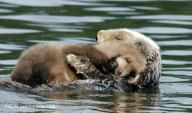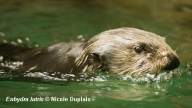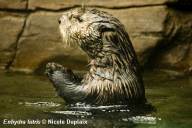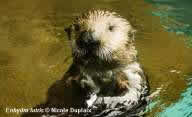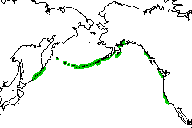
(click map for detailed version) |
|
|
|
Description
Sea otters (Enhydra lutris) are a member of the weasel family (Mustelidae) and are most closely related to river otters. Sea otters are the smallest marine mammal and suited to their marine environment by adaptations of dentition, skeletal structure, and pelage. Sea otter dentition is adapted for crushing hard-shelled invertebrates such as clams, urchins, and crabs. The skeletal structure of the sea otter is loosely articulated and lacks a clavicle which allows for increased flexibility in swimming and grooming. The forelimbs are used primarily for grooming and foraging rather than swimming. The hind feet are flattened and flipper-like with an extension of the fifth digit which enables the animal to more efficiently swim on its back on the surface of the water. Unlike other marine mammals, sea otters do not have blubber, instead they depend upon a dense, water-resistant fur to provide insulation against the cold. Sea otter fur is very dense and has a greater number of hair follicles per inch than any other mammal. Adult sea otters can reach lengths of up to 1.8 m but average about 1.4 m. Adult male otters weigh from 32-41 kg with some males reaching up to 46 kg. Adult female otters average 18-27 kg.
CITES Identification Sheet
Habitat
Sea otters forage in the benthos of rocky and soft-sediment communities, as well as within the algal understory and canopy in the subtidal zone, although otters also forage intertidally at times. They typically forage close to shore in waters less than 25-40 m in depth (Van Blaricom and Estes 1988, Estes 1980). In California they are primarily associated with subtidal habitats characterised by rocky substrata, although they occurs in sandy areas). Sea otter density within most of the range, with the exception of some areas at the northern and southern population front is related to substrate type. Rocky bottom habitats support higher number of animals than the sandy substratum.
Distribution
Historically, sea otters occurred in near-shore waters around the North Pacific rim from Hokkaido, Japan through the marine coastal areas of the Russian Far East and the Pacific coastal areas in the United States as far south as Baja California. Due to excessive harvest of sea otters during the Russian and Russian/American fur trade (1742-1911), the world-wide population was drastically reduced to just a few hundred animals. Remnant colonies of sea otters were identified in Russia, Alaska, and California. There are three subspecies of sea otter recognized: E. l. lutris (located in Russia along the Commander Islands, Kamchatka Peninsula, and Kuril Islands and in northern Hokkaido, Japan), E. l. kenyoni (located in Alaska with populations translocated to British Columbia, Canada, and Washington State), and E. l. nereis (located in California). The current world-wide population estimate for E. lutris is approximately 108,000.
Conservation Status
Red List Category EN (Endangered), decreasing
Year Assessed 2010
Assessors Doroff, A. & Burdin, A
Evaluators Conroy, J & Hussain, S.A. (Otter Red List Authority)
Studies from Alaska and California show a decrease in the number of sea otters of up to 90% (perhaps more in some areas) in western Alaska (because of predation by Killer Whales) 3-4% per year in California. The situation in the Russian Federation is unclear but, apparently it is still under threat because of poaching.
(Source: IUCN Red List)
Current Concerns
In the United States, sea otters are protected by the Marine Mammal Protection Act of 1972 (Act) and the U.S. Fish and Wildlife Service is the federal agency responsible for their conservation and management. In Canada, sea otters are protected and managed under the Species at Risk Act. There are currently two populations of sea otters listed under the Endangered Species Act in the United States, the southern sea otter (E. l. nereis) located along the California coast and the northern sea otter (E. l. kenyoni) in southwestern Alaska (which includes Alaska Peninsula and Bristol Bay coasts, the Aleutian, Barren, Kodiak, and Pribilof islands). The primary threats to the southern sea otter included, a restricted range, incidental mortality in commercial fishing operations, and environmental pollutants and disease agents that have reduced survival. The primary threats to the northern sea otter in southwest Alaska are less clear but may include increased mortality due to predation by killer whales (Orcinus orca).
The primary threats to the sea otter which are human related include: spilled oil and gas in the marine environment, boat strikes, disease agents from the terrestrial environment infecting sea otters, and habitat loss due logging activities in coastal areas. Other commercial operations that reduce the survival of sea otters include: entanglement in mariculture and commercial fishing nets and competition for shell fish resources. Coastal Alaska Native people are allowed to harvest sea otters for subsistence and handicraft purposes under the Act.
Current Research and Conservation Priorities (OSG Frostburg, MD 2004)
- In the modern world sea otters are oceanic emissaries, and they function as a keystone species in the nearshore marine system. Current studies have shown sea otters serve as important sentinels of changes in the health of their ecosystem. To address the many environmentally complex issues relating to sea otter conservation, we will continue the existing alliance of scientists, managers, agencies, non-profit organizations, and academic institutions that are working for the southern sea otter recovery and we propose to develop a similar capacity for the northern sea otter.
- To increase monitoring of health and disease agents in all three subspecies of sea otter through comparative and systematic approaches among populations. Standardized methods will have the potential to greatly improve our understanding of how agents affect a population and will help identify and mitigate anthropogenic causes of illness.
- Tto identify appropriate conservation measures for the declining northern sea otter population in southwest Alaska including listing under the Endangered Species Act
- To continue regional research and management meetings on an annual basis to share progress on current research programs and management issues.
- C continue research on sea otter population trend, life history, and community ecology to improve our ability to detect mechanisms of population fluctuation throughout the sea otter range
- Tto identify a plan for hosting an international sea otter meeting on a regular basis for which most of the research and managing entities can attend and provide input. Such a meeting may include elements of existing meeting formats such as the U.S. – Russia Sea Otter Working Group Meeting under the Area V Agreement.
- To continue to standardize methods of monitoring population abundance and health by collaboration with sea otter researchers and managers from Canada, Japan, and potentially Mexico
Researchers
Source: Angela Doroff,
IUCN/SSC Sea Otter Species Representative
Population Biology |
| Jack Ames |
|
Office of Spill Prevention and Response, State of California USA |
| Jim Bodkin |
|
U.S. Geological Survey, Alaska Science Center USA |
| Douglas Burn |
|
U.S. Fish and Wildlife Service, Marine Mammals, Alaska USA |
| Alexandar Burdin |
|
Alaska Sealife Center USA |
| Heather Coletti |
|
US Geological Survey, Alaska Science Center |
| Angela Doroff |
|
U.S. Fish and Wildlife Service, Marine Mammals, Alaska USA |
| George Esslinger |
|
U.S. Geological Survey, Alaska Science Center USA |
| Brian Hatfield |
|
U.S. Geological Survey, Western Ecological Research Center USA |
| Ron Jameson |
|
U.S. Geological Survey, Retired USA |
| Steve Jefferies |
|
Washington Department of Fish and Wildlife, USA |
| Alisha Kage |
|
University of California Santa Cruz, Long Marine Lab |
| Kim Kloecker |
|
US Geological Survey, Alaska Science Center |
| Sergey Kornev |
|
Marine Mammal Laboratory, KamchatNIRO, Russia |
| Svetlana Kornev |
|
Marine Mammal Laboratory, KamchatNIRO, Russia |
| Dan Monson |
|
U.S. Geological Survey, Alaska Science Center USA |
| Linda Nichol |
|
Fisheries and Oceans, Canada |
| Kathy Ralls |
|
Smithsonian USA |
| Ilya Shevchenko |
|
All Russian Research Institute of Fisheries and Oceanography, Russia |
| Don Siniff |
|
University of Minnesota, Retired USA |
Physiology |
| Brenda Ballachey |
|
U.S. Geological Survey, Alaska Science Center USA |
| Randall Davis |
|
University of Texas, Texas A&M USA |
| Kaoru Hattori |
|
Veterinary Medicine, Hokkaido University, Sapporo Japan |
| Shawn Larson |
|
The Seattle Aquarium USA |
| Mike Murray |
|
The Monterey Bay Aquarium USA |
| Terri Williams |
|
University of California, Santa Cruz USA |
Ecology |
| Gena Bentall |
|
Monterey Bay Aquarium, Monterey CA |
| Jim Estes |
|
U.S. Geological Survey, Western Ecological Research Center USA |
| Brenda Konar |
|
University of Alaska, Fisheries and Ocean Science, Fairbanks USA |
| Kristin Laidre |
|
University of Washington, Fisheries Sciences Seattle USA |
| Michelle Staedler |
|
The Monterey Bay Aquarium USA |
| Tim Tinker |
|
U.S. Geological Survey, Western Ecological Research Center USA |
| Glen VanBlaricom |
|
University of Washington, Fisheries Sciences Seattle USA |
| Jane Watson |
|
Malaspina University College, Canada |
| Nadezhda Zimenko |
|
All Russian Research Institute of Fisheries and Oceanography, Russia |
Disease/Health |
| Kathy Burek |
|
Alaska Veterinary Pathology Services USA |
| Verena Gill |
|
U.S. Fish and Wildlife Service, Marine Mammals, Alaska USA |
| Tracey Goldstein |
|
University of California, Davis |
| Frances Gulland |
|
The Marine Mammal Center, California |
| Dave Jessup |
|
Marine Wildlife and Veterinary Research Center, CDF&G USA |
| Melissa Miller |
|
Marine Wildlife and Veterinary Research Center, CDF&G USA |
| Pam Tuomi |
|
Alaska Sealife Center USA |
Distribution |
| Hiroshi Sasaki |
|
Preliminary survey on sea otters in the Northern sea of Japan. |
Publications
General
- Estes, J.A. (1980). Enhydra lutris. Mammalian Species 133: 1-8 + 3 figs
- Harris, C.J. (1968). Otters: A Study of the Recent Lutrinae. Weidenfeld and Nicholson, London
- Kenyon, K. W. (1969). The sea otter in the eastern Pacific Ocean. North American Fauna 68:1-352.
- Lensink C. J. (1962). The history and status of sea otters in Alaska. Ph. D. dissertation, Purdue University, West La Fayatte, Indiana
- Riedman, M. L. and J. A. Estes. (1990). The sea otter (Enhydra lutris): behavior, ecology, and natural history. U.S. Fish and Wildl. Ser. Biol. Report 90(14). 126 pp.
Ecology
- Estes, J.A., Tinker, M.T., Williams, T.M. & Doak, D.F. (1998). Killer Whale Predation on Sea Otters linking Oceanic and Nearshore Ecosystems. Science 282 (5388): 473-476
- Garshelis, D.L. & Garshelis, J.A. (1984). Movements and Management of Sea Otters in Alaska. Journal of Wildlife Management 48: 665-678
- Garshelis, D.L., Johnson, A.M. & Garshelis, J.A. (1984). Social Organization of Sea Otters in Prince William Sound, Alaska. Canadian Journal of Zoology 62: 2648-2658
- Loughlin, T.R. (1980). Home Range and Territoriality of Sea Otters near Monterey, California. Journal of Wildlife Management 44: 576-582
- Reidman, M.L., Estes, J.A., Staedler, M.M., Giles, A.A. & Carlson, D.R. (1994). Breeding Patterns and Reproductive Success of California Sea Otters. Journal of Wildlife Management 58: 391-399
- Ribic, C.A. (1982). Autumn Movement and Home Range of Sea Otters in California. Journal of Wildlife Management 46: 795 - 801
- Vandevere, J.E. (1969). Feeding Behaviour Of The Southern Sea Otter Proceedings Of The Sixth Annual Conference On Biological Sonar And Diving Mammals pp 87-94
Health
- Baskaran, M., Hong, G-H, Dayton, S. Bodkin, J.L. & Kelley, J.J. ( 2003 ). Temporal Variations Of Natural And Anthropogenic Radionuclides In Sea Otter Skull Tissue In The North Pacific Ocean. Journal Of Environmental Radioactivity 64: 1-18
- Home, E. & Menzies, A. (1796). A Description of the Anatomy of the Sea Otter, from a Dissection made November 15th, 1975, by Everard Home, Esq. F.R.S. and Mr Archibald Menzies. Communicated by Everard Home, Esq. Philosophical Transactions Of The Royal Society Of London, Series B, Biological Sciences 86: 385-394
- Ketten, D.R. (1998). Marine Mammal Auditory Systems: A Summary of Audiometric and Anatomical Data and its Implications for Underwater Acoustic Impacts. NOAA Technical Memorandum NMFS NOAA-TM-NMFS-SWFSC-256
- Larson, S., Jameson, R., Etnier, M., Fleming, M. & Bentzen, P. (2002). Loss Of Genetic Diversity in Sea Otters (Enhydra Lutris) Associated With the Fur Trade Of the 18th And 19th Centuries. Molecular Ecology 11: 1899-1903
- Morita, T., Kishimoto, M., Shimada, A., Matsumoto, (2001). Disseminated Histoplasmosis in a Sea Otter (Enhydra lutris) Journal of Comparative Pathology 125 (2/3): 219 -223
- Murphy, C.J., Bellhorn, R.W., Williams, T., Burns, M.S., Schaeffel, F. & Howland, H.C. (1990). Refractive State, Ocular Anatomy, And Accommodative Range Of The Sea Otter (Enhydra lutris) Vision Research 30 (1) : 23 - 32
Oil Spills
- Monson, D.H., Doak, D.F., Ballachey, B.E., Johnson, A. & Bodkin, J.L. (2000). Long-Term Impacts Of The Exxon Valdez Oil Spill On Sea Otters, Assessed Through Age-Dependent Mortality Patterns. Proceedings of The National Academy Of Sciences Of The United States of America 97(12): 6562-6567
Useful Links
Citizen Science
Current Conservation Status
Research and Conservation Agencies and Organizations Active in Sea Otter Population Management
Conservation Organizations Active in Sea Otter Issues
Alaska Native Organizations Active in Sea Otter and Subsistence Issues
|



